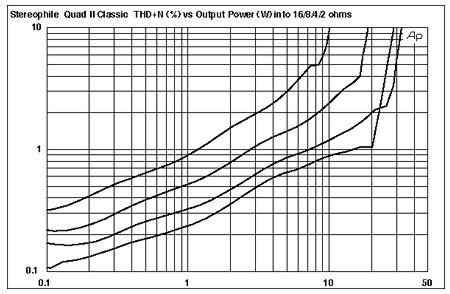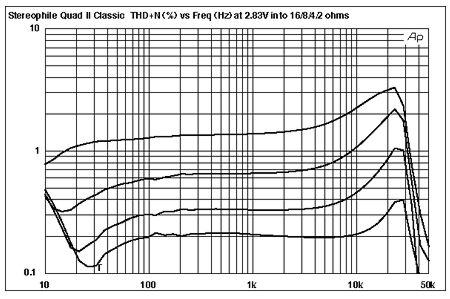| Columns Retired Columns & Blogs |
Quad II Classic monoblock power amplifier Measurements
Sidebar 3: Measurements
It was difficult to resist nostalgia as I set one of the Quad II Classic monoblocks up on my test bench; the original Quad II, made by what was then called the Acoustical Manufacturing Company, was the amplifier to lust over when I first became aware of hi-fi in the early 1960s. But I am a trained professional—I can't let such feelings interfere with the task at hand.
The Quad II's voltage gain into 8 ohms was typical of modern designs, at 26.55dB. Its input impedance was not typical, however, at more than 1 megohm across the audioband. The amplifier maintained absolute signal polarity (ie, was noninverting), and its source impedance was a high 1.86 ohms at 1kHz, this increasing very slightly at very low and very high frequencies. As a result, its frequency response into our standard simulated loudspeaker load (fig.1, top trace at 2kHz) varied by ±1dB and its output dropped significantly with decreasing load impedance. Even into 2 ohms (fig.1, bottom trace), however, the Quad's output is down by just 0.2dB at 20kHz and 0.5dB at 20Hz.

Fig.1 Quad II Classic, frequency response at 2.83V into (from top to bottom at 2kHz): simulated loudspeaker load, 16, 8, and 4 ohms (1dB/vertical div.).
What can also be seen in fig.1 is that a small ultrasonic peak develops at 52.5kHz into loads greater than 4 ohms. This correlates with the slight degree of overshoot and ringing seen in the amplifier's reproduction of 1kHz (fig.2) and 10kHz (fig.3) squarewaves into an 8 ohm load. But note the flat tops of the waveform in fig.2, confirming the amplifier's excellent low-frequency extension.

Fig.2 Quad II Classic, small-signal 1kHz squarewave into 8 ohms.

Fig.3 Quad II Classic, small-signal 10kHz squarewave into 8 ohms.
The Quad II seemed relatively uncritical regarding the grounding arrangements between it and my Audio Precision test set. Its A-weighted signal/noise ratio when optimally grounded was a moderately good 75.2dB ref. 1W into 8 ohms, this worsening to 67.2dB with a wideband, unweighted measurement.
The Quad's single output-transformer tap is optimized for an 8 ohm load impedance. Fig.4 shows how the measured THD+noise percentage in the amplifier's output varies with power into loads ranging from 2 to 16 ohms. Taking our usual definition of "clipping" as being 1% THD+N, the amplifier gives out the most power into 16 ohms (fig.4, bottom trace), 16W or 15.05dBW. However, relaxing the definition to 3% THD+N indicates that the Quad gives its maximum output into 8 ohms, at 27W (14.3dBW), compared with 24W into 16 ohms. However, this graph reveals that loads below 8 ohms are to be avoided, the Quad II delivering a maximum of 12W into 4 ohms and just 5W into 2 ohms, again at 3% THD+N.

Fig.4 Quad II Classic, distortion (%)vs 1kHz continuous output power into (from bottom to top): 16, 8, 4, and 2 ohms.
Fig.5, which plots the THD+N percentage against frequency at 2.83V into 2, 4, 8, and 16 ohms, also reveals that the amplifier is less happy with the lower impedances. Note, however, that the THD percentage doesn't rise by much at the top of the audioband, suggesting good open-loop performance. Even into 16 ohms, the midband distortion figure is about twice as high as that specified. However, the content of the distortion is primarily the subjectively innocuous second harmonic (fig.6). At low frequencies and high levels, the second harmonic was joined by the third (fig.7), presumably due to the transformer core starting to saturate, and some higher-order harmonics begin to poke their heads above the –80dB line.

Fig.5 Quad II Classic, THD+N (%)vs frequency at 2.83V into (from bottom to top): 16, 8, 4, and 2 ohms.

Fig.6 Quad II Classic, 1kHz waveform at 1W into 8 ohms (top), 0.34% THD+N; distortion and noise waveform with fundamental notched out (bottom, not to scale).

Fig.7 Quad II Classic, spectrum of 50Hz sinewave, DC–1kHz, at 8W into 8 ohms (linear frequency scale).
The Quad was only a moderate performer when it came to the HF intermodulation test. Asked to reproduce an equal mix of 19kHz and 20kHz tones just below visible waveform clipping into 8 ohms—10.5W—the amplifier produced a 1kHz difference tone at –44dB (0.6%), as well as some higher-level, higher-order products (fig.8). It is this behavior that will probably set a limit on the maximum loudness the amplifier will produce, rather than harmonic distortion per se (except at low frequencies).

Fig.8 Quad II Classic, HF intermodulation spectrum, DC–24kHz, 19+20kHz at 10.5W peak into 8 ohms (linear frequency scale).
Despite its design vintage, the Quad II Classic offered quite respectable measured performance.—John Atkinson
- Log in or register to post comments



































